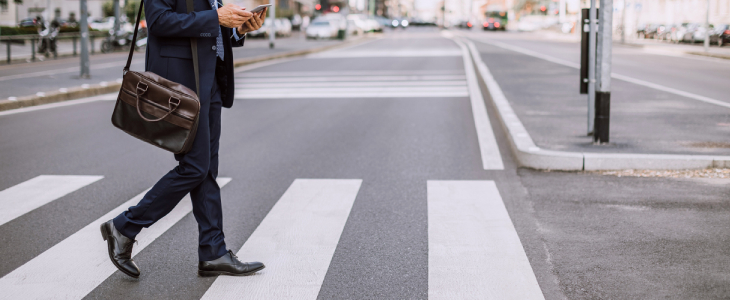In California, pedestrian accidents are a significant concern, with numerous incidents occurring annually. According to the National Highway Traffic Safety Administration (NHTSA), in 2021, there were 7,388 pedestrians killed in traffic crashes in the U.S., and 60,577 pedestrians were injured. In California, this is a particularly difficult problem, evidenced by the 1,108 pedestrian fatalities that occurred in the state in 2021. Many factors, from distracted driving to inadequate crosswalk design, contribute to these unfortunate events. Being well-informed about the causes, laws, and subsequent steps to take can be essential for those affected.
Common Causes of Pedestrian Accidents
- Distracted Driving: Many drivers split their attention between their phones or other devices and the road. This lack of focus can lead to missing vital signs, signals, or pedestrians, resulting in accidents.
- Speeding: When drivers exceed the speed limit or drive too fast for conditions, their reaction times decrease. This reduced window to respond can lead to accidents, especially in areas with heavy pedestrian traffic.
- Failure to Yield: At crosswalks and intersections, some drivers fail to yield the right of way to pedestrians. This negligent behavior can result in direct collisions with those on foot.
- Alcohol or Drug Impairment: Driving under the influence remains a leading cause of accidents. Impaired drivers have diminished judgment, coordination, and reaction times, making pedestrian accidents more likely.
- Poorly Designed Crosswalks and Intersections: In certain areas, the infrastructure itself can pose risks. Crosswalks without clear signage or intersections with limited visibility can contribute to accidents as drivers may not anticipate pedestrian movement.
California Laws Protecting Pedestrians
- Right-of-Way at Crosswalks: In California, drivers are required to yield the right of way to pedestrians in crosswalks. Whether the crosswalk is marked or unmarked, pedestrians have priority, and drivers must stop or slow down to ensure their safety. Violating this law can result in fines and penalties.
- No Passing at Crosswalks: When a vehicle has stopped at a marked or unmarked crosswalk to allow a pedestrian to cross, it’s illegal for another vehicle to overtake and pass the stopped vehicle. This law ensures that pedestrians aren’t endangered by impatient drivers.
- Pedestrian Signals: Pedestrians must obey traffic signals and signs, especially at intersections. If a pedestrian signal indicates a “Walk” or walking person symbol, pedestrians can proceed.
- School Zones: In areas near schools, there are often reduced speed limits to protect young pedestrians. Drivers are required to obey these lowered speed limits and to be extra vigilant during school hours when children might be present. Breaking these speed limits can lead to heavy fines and increased penalties.
Injuries Resulting from Pedestrian Accidents
Pedestrian accidents often result in serious injuries due to the vulnerability of individuals on foot compared to those in motor vehicles. Common injuries include traumatic brain injuries, which can have long-term cognitive and physical implications. Fractures, ranging from minor breaks to severe compound fractures, are also frequent. Additionally, spinal cord injuries, which can lead to paralysis or reduced mobility, can occur. Emotional and psychological trauma is another consequence, with victims sometimes experiencing post-traumatic stress disorder or depression following the incident.
Steps to Take After a Pedestrian Accident
After a pedestrian accident, it’s crucial to prioritize one’s safety and health. First and foremost, if able, move to a safe location away from traffic to prevent further harm. Next, it’s vital to report the accident to the police, ensuring that an official record of the event is documented. Gathering information from the driver involved and any witnesses at the scene can also be beneficial for future reference.
Seeking immediate medical attention is paramount, even if injuries seem minor initially; some injuries, like concussions or internal damages, may not manifest symptoms immediately. Once stabilized, consider preserving evidence from the scene, such as photographs or personal testimonies. It’s also wise to avoid discussing the accident in detail, especially on social platforms, as these statements could be used against you. Lastly, consulting with a personal injury attorney can guide legal rights and potential compensation avenues.
How a Personal Injury Attorney Can Help
A personal injury attorney possesses the expertise and knowledge needed to advocate effectively for victims of pedestrian accidents. They understand the intricacies of California law and can assess the merits of a case, ensuring that victims receive the compensation they rightfully deserve. Moreover, these professionals can negotiate with insurance companies, which often aim to minimize payouts, ensuring that the victim’s medical bills, lost wages, and other related costs are covered adequately. In addition, since pedestrian accidents frequently lead to severe injuries and sometimes claims of wrongful death, these cases often end up finding resolution in a courtroom.
Contact Ardalan & Associates If You’ve Been Injured in a Pedestrian Accident
Ensuring your rights and interests are protected after a pedestrian accident is paramount. The dedicated team at Ardalan & Associates is committed to guiding you through this challenging time. Reach out to us for a free consultation and the professional advocacy you deserve.
Ardalan & Associates, PLC is a personal injury law firm based in Thousand Oaks, serving all of Southern California including Los Angeles, Ventura, Kern, and Orange Counties. We are committed to helping our clients involved in pedestrian accidents seek justice and navigate their legal journey.
